by Linley Lutton
A compelling account of community disempowerment and poor city planning
The story of Elizabeth Quay in Perth, Western Australia needs telling. Perth is a relatively young coastal city of 1.7 million people. It has a Mediterranean climate, an easy-going lifestyle and a wonderful large central river. The city was assaulted by developers in the 1970s and 80s when the government allowed them to demolish almost every building of heritage value. The city is again being assaulted by the same desire to develop a so-called ‘modern city’.
Future generations will ask why this awful soulless development occurred. By telling and sharing the story, our grandchildren will know that there was a large group of people who tried their utmost to stop it, without success. Part of the story is to ensure this type of thing never happens again.
Central to this story is the disempowerment of the community in order to develop a commercial precinct on a 100 year old park specifically built in the nineteenth century for the people’s recreation – for ever. The disempowerment however goes further back in history. Perth’s Swan River is also regarded by Western Australia’s Aboriginal people as a sacred site.
There is no precedent in Australia, probably worldwide, where a prime heritage-protected city park on the banks of a river regarded as a sacred site by Aboriginal people has been resumed to enable a poorly planned commercial development to take place.
Many other cities around the globe are actively promoting the important contribution parklands make toward the long-term wellbeing of city residents. Western Australia however goes in precisely the opposite direction with supporters of the project deriding protesters as old ‘grass keepers’ who can’t accept change. Derision of protestors rather than defending the project is the standard tactic.
City waterfront redevelopment projects mostly originate because the land concerned is rundown, sometimes even abandoned, so authorities revitalise the area by turning the waterfront into a useful city asset.
In this case, there is no rundown land and no driving imperative to do anything at all. Many of Perth’s residents would like to see a more active river edge in the city’s CBD. A public river promenade with cafes, eateries, markets, community theatres, museums and galleries as well as areas for family recreation would fit well with the CBD and this could have been achieved without demolishing precious public park land. Low-rise apartments and hotels too could be part of such a vision.
Supporters of the project argue that the city needs vibrancy yet Elizabeth Quay will be primarily a precinct of high-rise offices offering no civic, cultural or general community benefit. A few bars and restaurants at ground level represent the primary community offering.
The park area approximates the size of a large sports arena. The plan is to construct more than ten 20 to 30 storey glass and aluminium office towers and a hotel all sitting on six storeys of car park podia surrounding the site. The water table is too high to allow basement parking.
Property experts have warned that Perth has sufficient commercial buildings and inner city land to meet the city’s office requirements for at least 30 years so this land is not needed and will probably take at least 30 years to develop.
These are the main concerns about this development:
• A site sacred to the Aboriginal people has been desecrated
• A prime heritage-protected park has been stolen from the community
• Dozens of 100 year old heritage-listed trees have been destroyed
• The community has had no input into the planning
• The government will not listen to valid community or professional concerns
• Buildings are too tall and dominate the space
• There is no development of any civic or cultural value
• Major traffic problems will be caused because the plan involves diverting a major road
• The development includes digging an inlet which cannot work
• The site is partly contaminated which may cause further problems to the adjoining river
• There are serious microclimatic problems associated with wind and overshadowing
• The government cannot afford the massive cost
• It is designed as an enclave rather than being integrated with the city
• The sites are too large and out of scale with their neighbours
• The development shows no respect for adjacent buildings and streets
• It engages with a gentle river in a very dominant and aggressive manner
• There is little non-commercialised open space for community recreation
Many prominent citizens were approached to help the community fight this project but these efforts were fruitless. Most people in this category need to have a good working relationship with the government to ensure their wealth creation continues so they say nothing.
Professionals such as architects, planners, engineers and builders rely on the government for work and none will speak out: the only ones willing to do so are retired or are academics.
So, this project proceeds exactly as a handful of government planners and architects wished because a government leader is determined to leave his mark on the city irrespective of community concerns and poor planning.
These are the essential steps in the evolution of this project:
• Prior to European settlement, the Aboriginal people regard this site as sacred land
• The sacredness of the site is well understood and has been celebrated and documented
• Perth is founded in 1829 as the capital of Western Australia
• In the 1890s, after decades of filling, the Esplanade Reserve is created for public recreation
• Tourists remark constantly about this beautiful feature of our city
• The Esplanade Reserve enjoyed continuous use as a place for community activity
• In the later part of the 20th century it became heritage-listed
• In the early years of the 21st century planners devised a sensitive waterfront development
• This development included preservation and enhancement of the park
• In 2008, the government planned to locate a train station adjacent the park
• They scrapped the sensitive waterfront plan
• They decided to ignore heritage laws and redevelop the Esplanade Reserve as an office precinct
• Their plans include making an inlet and diverting a major road
• They sell their plan with unsubstantiated claims that 6 million tourists will visit the site each year
• Experts warned that the inlet will not work and the traffic consequences will be serious
• Property experts warned that there is no demand for this development
• Economists warned that the government cannot afford to undertaken such an expensive project
• Government Under Treasurer warns that too much development is occurring in the city
• All these warnings were ignored
• After the project was announced a period of public comment was allowed
• The government ignored every comment criticising their plans
• The Australian Institute of Urban Studies held a forum to warn about the many problems
Teir concerns were ignored:
• A people’s petition with 13,000 signatures was submitted to parliament in 2012
• It was ignored
• The government employed a specialist traffic consultant
• They instructed the consultant to limit the data used in order to achieve a better result
• In 2013 The University of Western Australia carried out testing of the river
• They found it takes 75 days for water to clear in this part of the river
• This result signalled major concerns that the inlet will not
• The government ignores the results
• Marine engineers working on the current project have been sworn to secrecy
• Alternative plans were presented to the government and ignored (see example below)
• The Indigenous Cultural Centre, the only development of civic value, is deleted from the project
• Work at Elizabeth Quay then started in 2012 revealing a seriously contaminated site
• Two streets of 100 year old heritage listed trees were destroyed for new services
• The government said the trees could not be relocated because the soil is too contaminated
• The government was repeatedly warned about its increasing debt levels
• In 2013 the government lost its AAA credit rating due to overspending
• They continue with the project regardless while cutting spending in essential services
Many professionals are involved in the development of Elizabeth Quay. It is alarming that they cannot see the major problems associated with their work. Perhaps they do see the problems and simply choose to do as they are told by bureaucrats. Either way, they will be held accountable in the years ahead.
Elizabeth Quay is put forward in this article as an example to others of poor urban planning. It should act as a warning that poor urban planning outcomes will eventuate when there is a political desire which overrides common sense and community values. If we are to inhabit cities which support our wellbeing and nurture our growth we must show the current generation of profligate developers and governments that there are far better ways to build cities. True long-term sustainability in our urban environments comes from a collaborative approach between the community and government. A bottom-up approach to city planning is essential. This requires the involvement of the grass roots community. Planners and architects working on their own do not have the answers. We owe it to our children and our grandchildren to fight for better city planning and community empowerment.
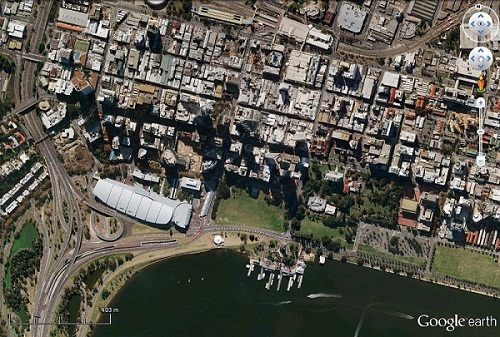
Above is The Esplanade Reserve, which was created in the 1890s as a ‘permanent’ recreational and community space
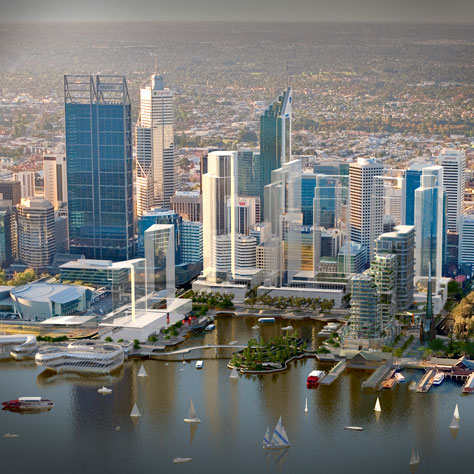
This is the commercial project known as Elizabeth Quay which is being built on The Esplanade Reserve. This is a non-essential government project which the majority of people don’t want.
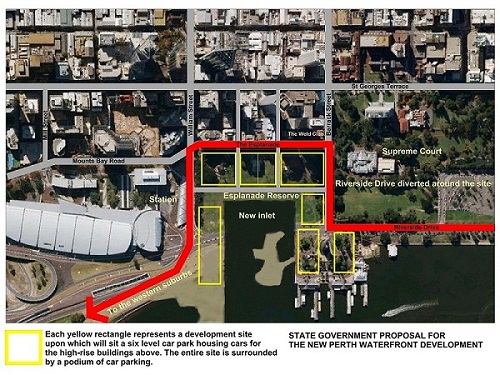
The plan involves diverting this major city through-road around the site. The road carries 40,000 vehicles per day. There are currently major traffic congestion problems in the city and this diversion will cause further problems.
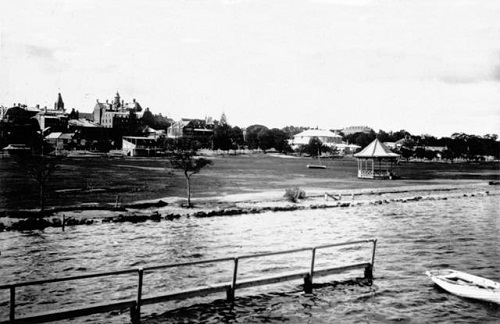
The Esplanade Reserve when it was completed in the 1890s.
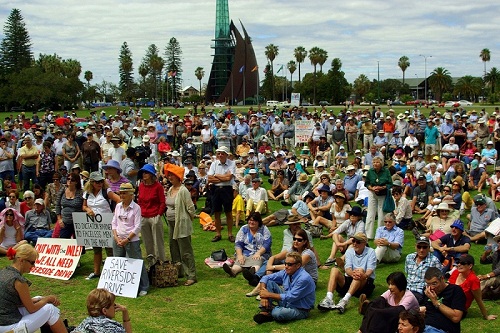
People protesting against the development on The Reserve in 2012